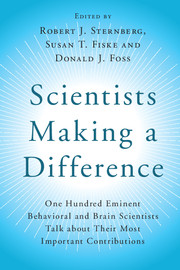 Scientists Making a Difference
Scientists Making a Difference from Section B - Learning and Memory
Published online by Cambridge University Press: 05 August 2016
I was drawn in another direction – deeper into the duck/rabbit hole. If what we see and remember depends on what we already know or how we interpret what we see, and includes inferences that may not be true … what ties our beliefs to reality? It may be all right for you to remember a duck and me to remember a rabbit, but certainly there was no elephant! How do we discriminate between reasonable alternative constructions of reality and fabrication? Are there differences in the memories created by perceptual processes and those created by inference, imagination, fantasy, and dreams? How do we determine if autobiographical memories are false? Where do minor distortions end and major distortions (hallucinations or delusions) begin?
I began exploring the psychological processes by which people discriminate real from imagined events. Carol Raye (then on the faculty of Barnard College) and I mapped out a set of empirical questions and a strategy for studying the problem of what we called “reality monitoring.” Our 1981 Psychological Review paper proposing a theoretical framework for reality monitoring is perhaps the paper that has been the most consequential for me. It clarified the nature of the fundamental question that attracted me to experimental psychology to begin with and that frames how I've thought about many domains involving human cognition. Shahin Hashtroudi, Steve Lindsay, and I extended this reality monitoring approach to the general problem of identifying the origin of mental experience (calling it the “source monitoring framework”). Our 1993 Psychological Bulletin paper is my lab's most highly cited paper, and thus had the broadest impact. There are now many studies from our lab and other labs exploring reality/source monitoring, investigating the factors that affect whether people confuse memories of what they perceived with memories of what they imagined, what they saw with what they heard, and so forth. Some of our findings and theoretical ideas have influenced work on eyewitness testimony, interpreting reports of recovery of repressed memories, understanding hallucinations and delusions in psychopathology and confabulations in brain-damaged patients, and episodic memory in general, and have influenced studies of the cognitive neuroscience of memory.
To save this book to your Kindle, first ensure [email protected] is added to your Approved Personal Document E-mail List under your Personal Document Settings on the Manage Your Content and Devices page of your Amazon account. Then enter the ‘name’ part of your Kindle email address below. Find out more about saving to your Kindle.
Note you can select to save to either the @free.kindle.com or @kindle.com variations. ‘@free.kindle.com’ emails are free but can only be saved to your device when it is connected to wi-fi. ‘@kindle.com’ emails can be delivered even when you are not connected to wi-fi, but note that service fees apply.
Find out more about the Kindle Personal Document Service.
To save content items to your account, please confirm that you agree to abide by our usage policies. If this is the first time you use this feature, you will be asked to authorise Cambridge Core to connect with your account. Find out more about saving content to Dropbox.
To save content items to your account, please confirm that you agree to abide by our usage policies. If this is the first time you use this feature, you will be asked to authorise Cambridge Core to connect with your account. Find out more about saving content to Google Drive.